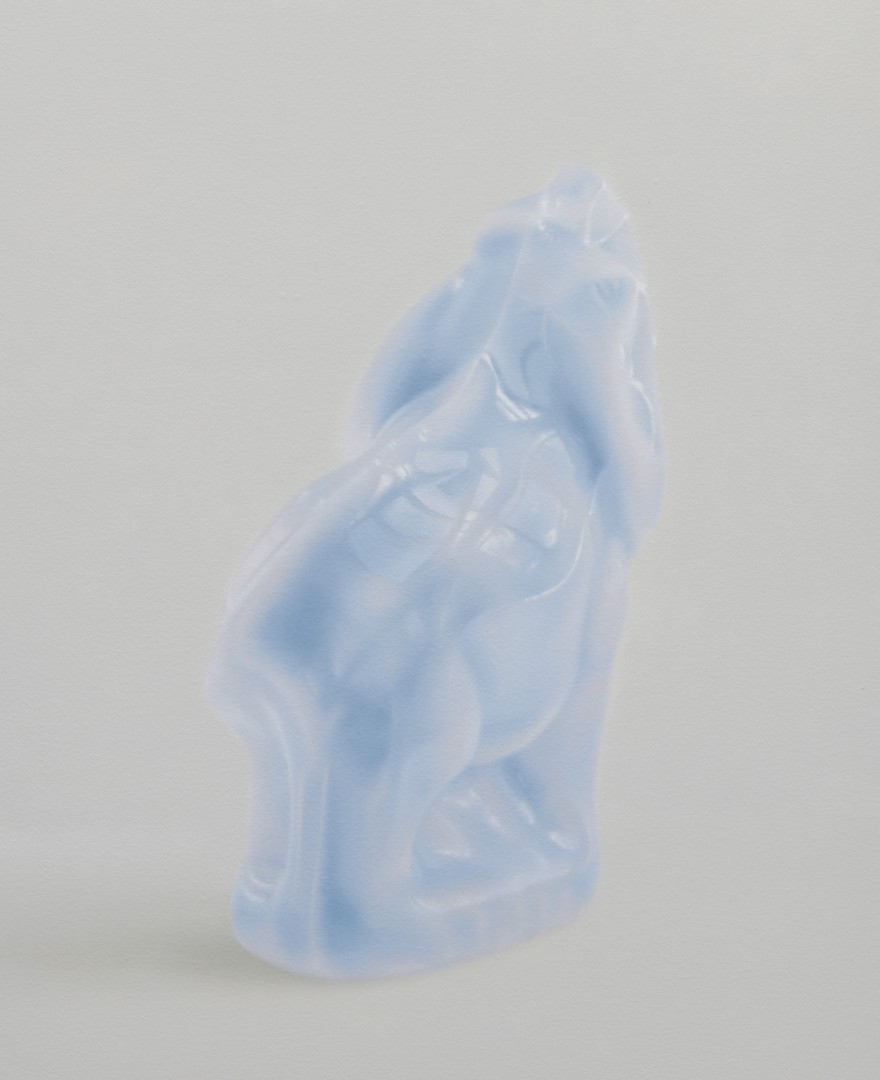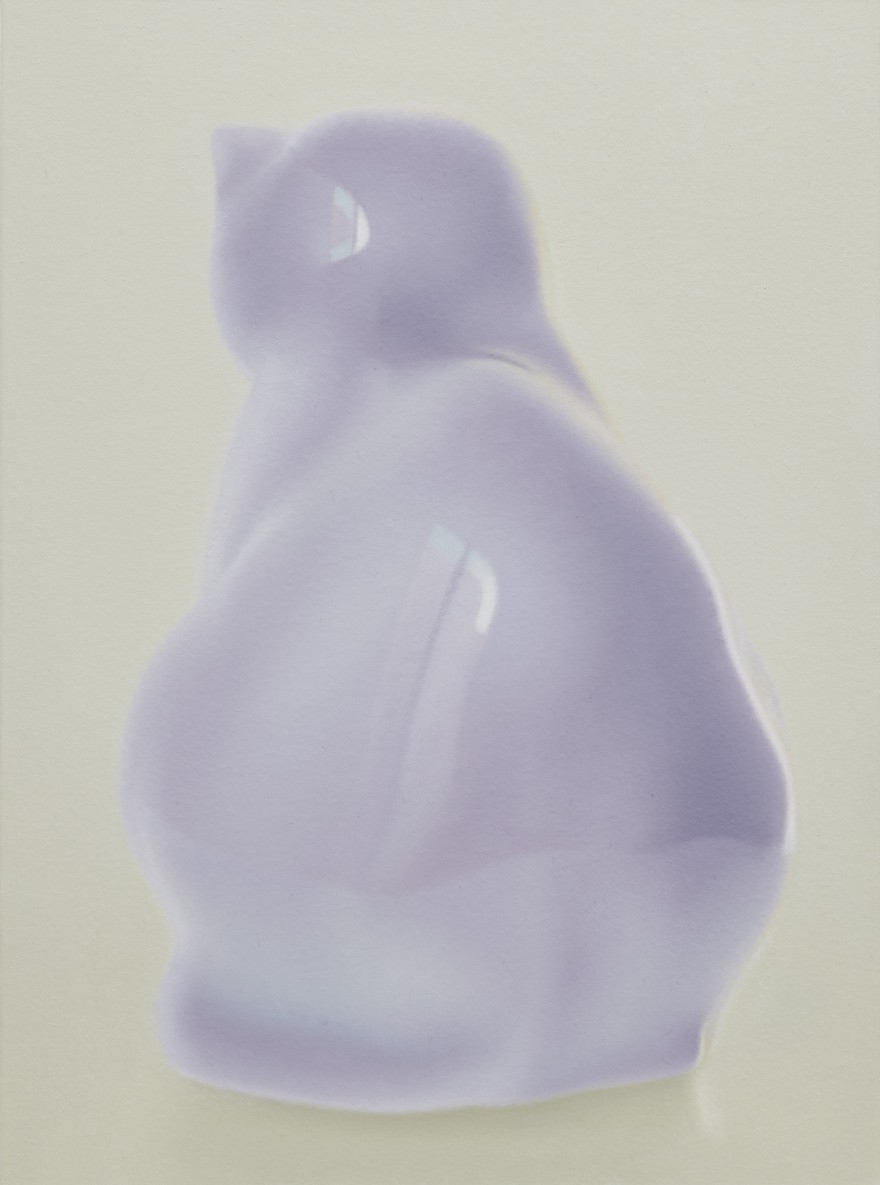Cultural Currency 7: "Yasuko Iba solo exhibition" @ imura art gallery
Beyond confronting and beholding
By Shimizu Minoru
2022.12.24

The German romantic poet Novalis left behind the literary fragment, “All that is visible clings to the invisible.”1 The “texture” that Iba Yasuko explores is none other than the feeling of “being in touch with” something beyond the visible. Iba’s work to date is nothing short of variations of this texture.
Here, “texture” is not the texture of the fruit, cushions or other objects depicted in the works. For example, while referencing Gerhard Richter, Iba’s early works up to the late 1990s took as their departure point close-up photographs of fruit and jam in which particular areas were in focus, sprinkled with sparkling highlights and tinged with a fresh feeling of translucence. In other words, the “texture” expressed in these early works was a photographic feeling of translucence.
In the 2000s, having grown dissatisfied with texture as a photographic feeling of translucence, the artist began depicting textures derived from soft, indirect light. Reflections of light and highlights disappeared as Iba produced one series after another featuring cushions and sofas of the kind that make one want to bury one’s head in them amid indirect light and subdued colors. In due course, inspired by embroidered cushions, she discovered that texture derives from the struggle between the two evenly matched forces of things swelling due to the effect of expansive colors and the curved lines of the embroidery gently suppressing this. According to Iba, this occurs “above the fabric, but below the pattern.” As a derivative of this, the series featuring blue-and-white porcelain depicted “above the clay body, but below the glaze” was born. With this, it appeared as if the feeling of translucence of her early work had been reintroduced, but this immersion in translucent textures was soon superseded by her next style.
In the 2010s, Iba broke away from so-called visuo-tactile texture as she came to the realization that texture arose inside the viewer (inside the mind, inside the brain). In other words, people “see” texture in their brains. So, what exactly does “seeing” entail? The series featuring pictures of vessels peeking in our direction through gaps in white or semi-transparent curtains, the works in which single vessels stare back at us from transparent spaces in which virtual and real images become entangled due to the diffuse reflections of glass that cover the entire picture plane, and the works in which single vessels seem to stand opposite their own virtual images are not works that entice by immersing us in beautiful diffuse reflections. The artist’s interest lay in “seeing” paintings, and the works maintained a tense balance between the danger (not seeing anything) and certainty (seeing everything) around this.
In 2019, in parallel with these works, Iba began producing original pointillist prints using silkscreens. Pointillism is a technique in which, in order not to reduce the saturation of the colors, paint is applied without mixing it in a series of fine dots that sit next to each other, so that inside the viewer’s brain it appears as if the colors are mixed. In Iba’s pointillism, because tiny, non-circular dots are printed close together, the colors all blend together and appear grey, a color that is not actually present, the colorful dots that are actually printed, too small to be perceived. The result calls to mind the mysterious remoteness of early photographs from the 19th century.
 Born as an extension of the “remote” “landscapes” opened up by these pointillist prints is the most recent series of landscape paintings, which is Iba’s present location. The pointillist landscapes were landscapes that manifested not in the eyes but in the brain. Characterized by pale green and sky blue, these landscape paintings are based on scenery photographed with an infrared camera. Which is to say they represent a world visible outside the visible light spectrum. Scenery visible outside the visible light spectrum, or in other words with one’s eyes closed, perhaps signifies scenery that appears in a dream or while sleeping. Points of view for “seeing” this scenery do not exist outside the scenery itself. It is probably no surprise that the works in this series appear somehow surrealistic. They at once resemble unrecalled scenery in one’s memory and scenery one will see in the future. Here, the texture of the paintings appears as something that should evoke memories and premonitions.
Born as an extension of the “remote” “landscapes” opened up by these pointillist prints is the most recent series of landscape paintings, which is Iba’s present location. The pointillist landscapes were landscapes that manifested not in the eyes but in the brain. Characterized by pale green and sky blue, these landscape paintings are based on scenery photographed with an infrared camera. Which is to say they represent a world visible outside the visible light spectrum. Scenery visible outside the visible light spectrum, or in other words with one’s eyes closed, perhaps signifies scenery that appears in a dream or while sleeping. Points of view for “seeing” this scenery do not exist outside the scenery itself. It is probably no surprise that the works in this series appear somehow surrealistic. They at once resemble unrecalled scenery in one’s memory and scenery one will see in the future. Here, the texture of the paintings appears as something that should evoke memories and premonitions.
 However, when we look at a painting, we inevitably confront and “behold” it with both our eyes and our brains from the viewpoint imposed in advance according to where it is exhibited. It goes without saying that for the purposes of exploring this experience, scenery that is visible with our eyes closed, or scenery without a viewpoint, is unfair. As if to make up for this deficiency, starting with the solo show at Misa Shin Gallery, Iba launched a series of what in a sense are still life paintings, each depicting a single, small ceramic object (animal) against a plain background (three were exhibited at this show). To all intents and purposes a new series, these small works (two of the pieces in this show are the first attempted on a large scale) are still lifes in which the thing we are supposed to be looking at is limited to a single object, and while the restriction to vertical format gives them the appearance of portraits, not only is the nature of the animal depicted sometimes unclear, but it is always shown with its back turned towards the viewer. The main distinguishing characteristic is the sense of distance, or in other words the exquisite manner in which space is left. The ceramic objects with their glossy textures do not take up enough area to immerse the viewer as was formerly the case, but neither are they small enough to generate any unnecessary meaning (insignificant, isolated and lonely, etc.) within the overall picture plane. And while a minimal level of spatiality is expressed by adding a faint shadow to the base of each object, the remainder of the blank space is thoroughly and uniformly painted over in a matt cream color reminiscent of washi paper or an earthen wall. We stand facing an animal imbued with an appealing texture and observe it closely from behind. It goes without saying that this is a fleeting metaphor for viewing a picture.
However, when we look at a painting, we inevitably confront and “behold” it with both our eyes and our brains from the viewpoint imposed in advance according to where it is exhibited. It goes without saying that for the purposes of exploring this experience, scenery that is visible with our eyes closed, or scenery without a viewpoint, is unfair. As if to make up for this deficiency, starting with the solo show at Misa Shin Gallery, Iba launched a series of what in a sense are still life paintings, each depicting a single, small ceramic object (animal) against a plain background (three were exhibited at this show). To all intents and purposes a new series, these small works (two of the pieces in this show are the first attempted on a large scale) are still lifes in which the thing we are supposed to be looking at is limited to a single object, and while the restriction to vertical format gives them the appearance of portraits, not only is the nature of the animal depicted sometimes unclear, but it is always shown with its back turned towards the viewer. The main distinguishing characteristic is the sense of distance, or in other words the exquisite manner in which space is left. The ceramic objects with their glossy textures do not take up enough area to immerse the viewer as was formerly the case, but neither are they small enough to generate any unnecessary meaning (insignificant, isolated and lonely, etc.) within the overall picture plane. And while a minimal level of spatiality is expressed by adding a faint shadow to the base of each object, the remainder of the blank space is thoroughly and uniformly painted over in a matt cream color reminiscent of washi paper or an earthen wall. We stand facing an animal imbued with an appealing texture and observe it closely from behind. It goes without saying that this is a fleeting metaphor for viewing a picture.

 Iba’s present location—landscape paintings that are essentially variations on similar scenery in similar color tones, and still lifes limited to a single motif (i.e. portraits)—is like a laboratory where the conditions are reduced to a minimum. As noted at the start, Iba’s paintings have consistently explored “texture,” and have been created in the space between the existence and nonexistence of things that possess it, in the space between the possibility (visible) and impossibility (invisible) of perceiving it. Having started out as a printmaker, the oil painting that she later turned to is of her own style that is almost completely unrelated to traditional oil painting. If one were to compare her path in this pursuit of her own style of oil painting between painting and printmaking, between painting and photography, to mountain-climbing, it seems she is at a gently sloping midway point preparing her next move.
Iba’s present location—landscape paintings that are essentially variations on similar scenery in similar color tones, and still lifes limited to a single motif (i.e. portraits)—is like a laboratory where the conditions are reduced to a minimum. As noted at the start, Iba’s paintings have consistently explored “texture,” and have been created in the space between the existence and nonexistence of things that possess it, in the space between the possibility (visible) and impossibility (invisible) of perceiving it. Having started out as a printmaker, the oil painting that she later turned to is of her own style that is almost completely unrelated to traditional oil painting. If one were to compare her path in this pursuit of her own style of oil painting between painting and printmaking, between painting and photography, to mountain-climbing, it seems she is at a gently sloping midway point preparing her next move.
——————————–
1 Novalis, Novalis: Philosophical Writings, trans. and ed. Margaret Mahony Stoljar (Albany: State University of New York Press, 1997), 118. Shimizu Minoru
Critic. Professor, Doshisha University.
“Yasuko Iba solo exhibition” was held at imura art gallery, December 2 through 23, 2022.

Untitiled 2022-08, oil on canvas, 194x162cm

Untitiled 2022-09, oil on canvas, 80.3×65.2cm

Untitiled 2022-10, oil on canvas, 80.3×65.2cm

Untitiled 2022-11, oil on canvas, 45.5×33.3cm
——————————–
1 Novalis, Novalis: Philosophical Writings, trans. and ed. Margaret Mahony Stoljar (Albany: State University of New York Press, 1997), 118. Shimizu Minoru
Critic. Professor, Doshisha University.
“Yasuko Iba solo exhibition” was held at imura art gallery, December 2 through 23, 2022.